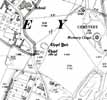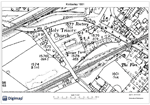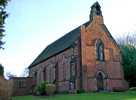For this church:    |
|
 Kimberley chapel, c.1790 Kimberley chapel, c.1790 |
 Location of the chapel Location of the chapel on an OS map (1899) Reproduced with the permission of the National Library of Scotland |
The first record of a church here is in 1298. The building stood opposite Manor Farm on Granger’s Hill, approximately half a mile south-east of the site of the present church. By 1448 the parish of Kimberley was depopulated and it was merged with Greasley. The church subsequently fell into disrepair and the ruins were sketched by John Throsby in the 1790s. By the 1830s it had entirely disappeared.
Worship continued some two miles away at St Mary’s Church, Greasley, but by the 1840s, due to the expansion of coal mining, hosiery manufacture and brewing, the population of Kimberley had grown dramatically and was in need of its own church.
 Ordnance Survey map Ordnance Survey mapof Kimberley (1881) © Crown Copyright and Database Right 2016. Ordnance Survey (Digimap Licence) |
A proposal for a new church, parsonage house and school was published in the Nottingham Review in June 1844. Lord Melbourne, the main landowner in the village, gave the site for the church at Kettle Bank (now known as Church Hill) and donated £300 towards the cost of building. The Nottinghamshire Church Building Society granted £500, The Incorporated Society for Promoting the Enlargement, Building and Repair of Churches and Chapels (a private and independent national church building society, often referred to as the Church Building Society) gave £400 and The Parliamentary Commissioners for building Churches, £200.
It was built over the period 1846-7 and consecrated on 18 May 1847 as Holy Trinity. The cost of its construction was reported to be £2,300. The construction company of Robert Barber (Eastwood) designed and built the church, supervised by the Derby architect Henry Isaac Stevens.
On 11 October 1848 Kimberley was constituted a chapelry district, and in January 1851 it became a rectory on the annexation of the tithe rent charges. It was provided, however, that the ecclesiastical fees of the new parish should be retained by the vicar of the mother church to the end of his incumbency.
Under this arrangement the incumbent of Kimberley was a perpetual curate until the demise of the vicar of Greasley, the Rev. John Hides, in 1866. The fees then became payable to the incumbent of Kimberley, who became vicar. Subsequently an Act was passed which gave the title of rector to any incumbent who should recover or secure some tithes for his benefice.
In 1851 William Clementson returned general congregations of 63 in the morning and 193 in the evening, with 49 and 78 Sunday Scholars respectively in the morning and afternoon. He estimated the general congregation average for the past twelve months as 85 in the morning and ‘about’ 400 in the evening, with 66 and 83 Sunday scholars in the morning and afternoon. The Sunday School was held in the church because there were no parochial schools. According to Clementson ‘there would be a much larger attendance of children had we suitable accommodation’.
In 1851 Kimberley also contained a group of Wesleyan reformers meeting in a Wesleyan chapel (1822), a Methodist New Connexion chapel (built 1830), a Primitive Methodist chapel (1850), and a general Baptist chapel (1844).
When Bishop Hoskyns visited Kimberley on 2 March 1911, 173 children were enrolled on the church school, 212 in the Sunday School, and 57 baptisms had taken place over the previous 12 months. There was also a Mission Hall (dating from pre-1885) which had 101 children on the Sunday School roll, and seven baptisms had taken place over the previous twelve months.
There was a major restoration in 1937 that included the building of a new choir vestry against the north wall of the nave, and installation of new choir stalls and chancel furniture. The total cost of the work was £885. In addition, the Hanson family gifted a new organ in memory of Mr F. W. Hanson. A service of dedication and thanksgiving, led by the Bishop of Southwell, was held on 8 November.






